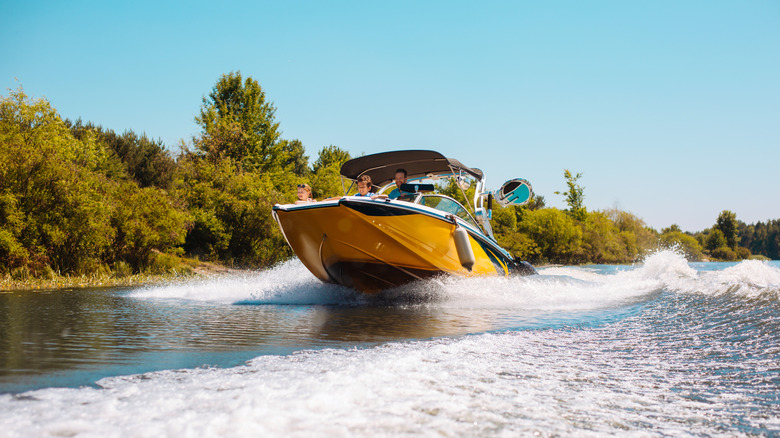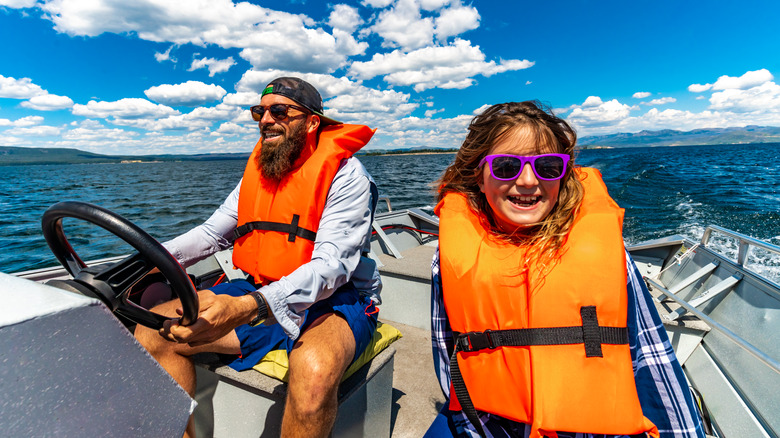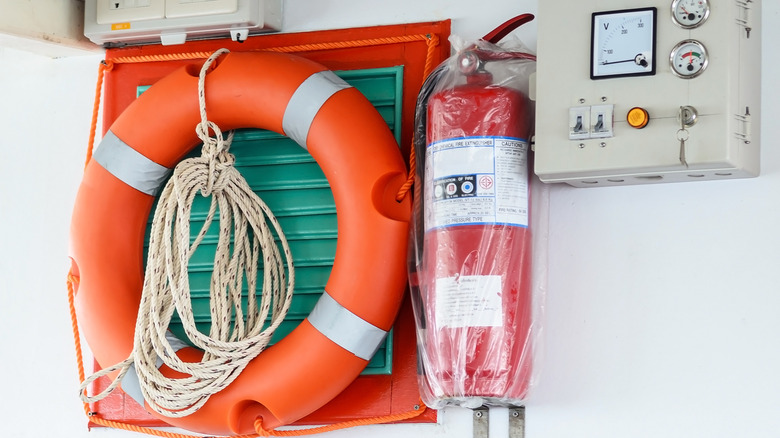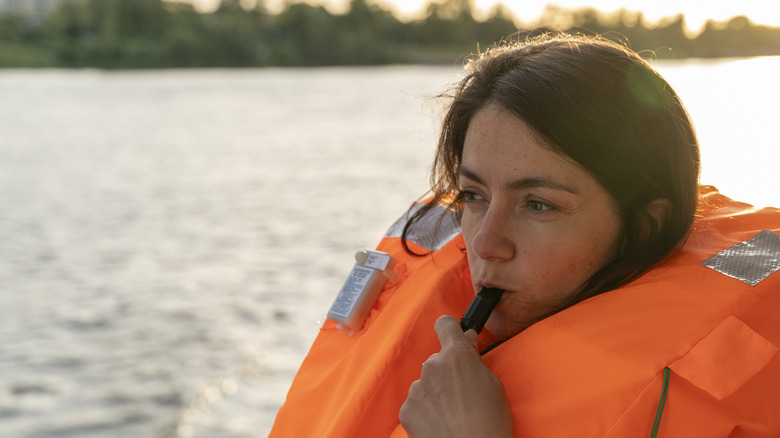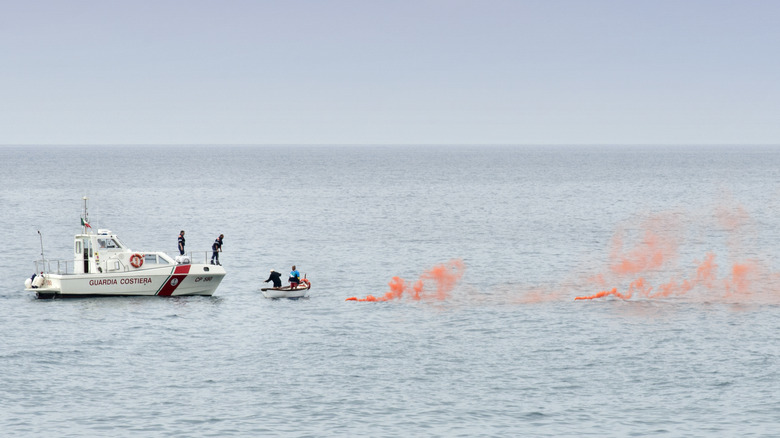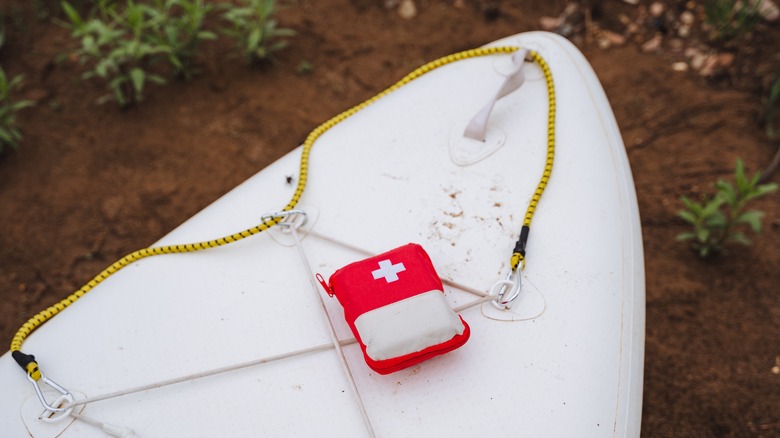Lifesaving Equipment Every Boater Should Have For Any Emergency Situation
The warmer weather that comes with the spring and summer seasons results in an increase in boating activity across the country. Unfortunately, this time of year also sees an uptick in boating accidents and emergencies, with the Fourth of July typically being the zenith of on-the-water accidents each year. Regardless of the type of boat — sailboat, motor boat, jet ski, etc. — or body of water — lake, river, bay, ocean — there is emergency equipment that every boater should have.
Some of this equipment is required by the U.S. Coast Guard, while other pieces of emergency equipment are imperative to ensure boaters can properly respond to any emergency situation. For instance, having and properly utilizing this safety equipment can help you survive if your boat capsizes, signal for help if you are lost at sea, or provide first aid to someone until help arrives. These are just a few examples of the dangers faced by kayakers, boaters, and other watersport enthusiasts. So, beyond just making sure they have all the items on the checklist aboard their vessel, boaters need to be aware of the purpose of the items and how to use them.
Life jackets and throwable devices literally save lives
Almost anyone who has been on or around the water is familiar with life jackets, as they are perhaps the most recognizable piece of boating safety equipment. However, knowing what a life jacket is and wearing one are two different things. Unfortunately, despite Coast Guard requirements, far too many people who are on the water do not wear their life jackets. Drowning is one of the most common ways people die while fishing or boating. Life jackets help prevent that. But, in almost 90% of boating accidents that result in drowning, the individual was not wearing one, according to Bass Resource.
There are a variety of reasons why people do not wear a life jacket, but the bottom line is there legally has to be a life jacket for everyone on board and everyone needs to wear it. Part of the solution is choosing the right life jacket, as there are a wide range of styles. The proper life jacket should be chosen on its fit –- so you are more likely to wear it –- and the activities it was intended for -– water skiing, fishing, paddling, etc.
In addition to life jackets, boaters are required to carry another type of floatation – a throwable device. These are essential for overboard rescue situations. The iconic life ring is probably what most people would be familiar with as far as throwable devices. However, for smaller boats, devices such as throwable cushions are more stowable, serve multiple uses, and still meet Coast Guard requirements.
Fire extinguishers douse flames on boats
It is almost unimaginable to think of a building or house not having a fire extinguisher. But, many people do not realize that fire extinguishers are just as essential on boats, even though they are surrounded by water. In fact, fire extinguishers are one of the pieces of equipment that is required under Coast Guard regulations for any size boat that has an engine. This includes personal watercraft (PWC) such as jet skis. Requirements vary based on the size of boat but every boat is required to have a fire extinguisher that is in working condition and not expired. So, it is essential not just to equip your boat with a fire extinguisher, but to periodically check to make sure it is operable and up-to-date. You should stow your extinguisher where it is accessible, but not exposed to excessive amounts of water, if possible. Under the console is a common mounting spot on smaller boats.
Utilizing a fire extinguisher on a boat is essentially the same as using one on land. However, you should take time to familiarize yourself with the model with which your boat is equipped. In a fire emergency, the acronym PASS is an easy way to remember the four steps of using a fire extinguisher: 1. Pull (the pin); 2. Aim (at the base of the fire); 3. Squeeze (the handle); 4. Sweep (the extinguisher side to side across the base of the fire).
Signaling devices
In addition to life jackets, throwable devices, and fire extinguishers, vessels of every size are also required to have some sort of sound-signaling device on board. This regulation applies to all boats whether or not they are utilizing an engine. So, this means even paddlers need to be sure to carry a sound-signaling device. As is the case with fire extinguishers, the type of sound signaling device which is required varies based on the size of the vessel and can range from a whistle to a horn or even a bell. Be sure to check the Coast Guard requirements for your size of vessel.
The purpose of these sound-signaling devices is to communicate with other boats and boaters. Just a few of the reasons this may be necessary include alerting other boats to your presence -– especially during periods of low visibility, letting them know what course of action you intend to take, or hailing help in an emergency. In addition to carrying a sound signaling device, it is important you know how to properly use it. To that end, every boater should spend some time learning navigation sounds and maneuvering signals, as explained by Boat U.S. Foundation.
Visual distress signals let other boaters know you're in trouble
Visual distress signals are just what the name implies –- they provide a way to visually signal others when you or your boat is in distress. As you might imagine, day and night require different types of visual distress signals. Not all boaters are required to carry both. According to current Coast Guard regulations, boats under 16 feet in length only need to carry nighttime visual distress signals, while all other size boats must carry both night and day versions. Again, this applies to all boats, regardless of the source of power (motor, sail, etc). Examples of daytime visual distress signals include orange distress flags, smoke distress signals, sea marker dye, and mirrors. Electric signal lights can be used for nighttime visual distress signals, while handheld flares, parachute flares, and pyrotechnic flares can be used for both day and night distress signals.
As is the case with all emergency equipment, it is imperative you are familiar with when and how to use visual distress signals, store them properly, and make sure they are in good working order. Additionally, it is always handy, though not required, to carry a flashlight. Not only can it be used to signal in an emergency situation, but it can be used to find necessary equipment and even help navigate if necessary.
First aid kit allows you to render assistance in an emergency
A first aid kit should be considered an essential item to bring on any outdoor adventure. So, while the Coast Guard currently only requires certain boats, such as inspected vessels, to carry a first aid kit, every boater certainly should have one on board — even if they aren't required. Of course, "first aid kit" is a relatively generic term that can refer to a myriad of containers filled with differing amounts of medical supplies and equipment. The idea when boating is to carry the most extensive kit that is practical for your size of vessel. For example, a first aid kit carried by a kayaker may closely resemble one used by a backpacker while the first aid kit aboard a 40-foot cabin cruiser may appear to be a piece of luggage.
While having at least basic first aid supplies on board can be crucial in an emergency situation, it is also imperative that they be kept clean and dry between uses if they are to serve their intended purpose. To that end, it is a good practice to keep first aid supplies in either a dry box or at the very least a dry bag.
